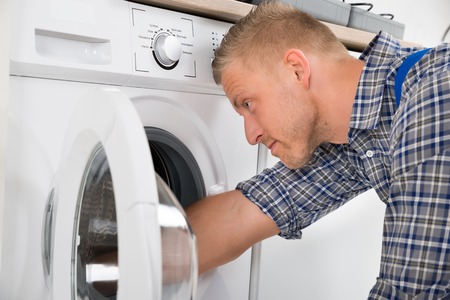Can you imagine a day when the most hardworking household appliance stops working? Yes, I am talking about the washer. When the washing machine malfunctions, dirty clothes keep piling up. If you don’t take steps to deal with the problem, it could upset your daily routine. One of the easiest ways of dealing with the problem is by calling washer technician. However, if you want to save a few bucks, you could try to repair the machine without getting help from washer repairman.

One of the problems that you are likely to face is that washer does not spin. In this article, we have given details of parts that are likely to cause this problem, and you can do to troubleshoot the problem.
Motor Coupling
Most top loading machines use a coupling to transfer power to the transmission. The coupling which connects the transmission to the motor consists of drive forks with a rubber coupling between them. The drive forks are attached to the transmission input shaft and the drive motor shaft. When the shaft rotates, the coupling between the forks absorbs the torque which prevents them from breaking. Regular use of the machine can wear out the coupling, which can cause the forks to slip, preventing it from engaging the clutch and transmission. When the coupling fails, the machine will fill and drain water, but it will not spin or agitate. To gain access to the coupling, you must remove the cabinet. Make sure you disconnect power supply to the machine before you attempt to repair the coupling.
Door Lock Assembly
The door lock prevents the door from opening when the machine is in operation. The assembly includes a strike on the machine door and a locking mechanism on the body of the appliance. The assembly also contains a door switch that sends an indication to the timer or control board when the door is locked, which allows the spin cycle to operate. When there is a problem with any of these parts, the control board or timer does not receive any indication that the door is locked, and the machine will not spin. Some new washers will display an error code when there is a problem with the door assembly. If your machine is displaying these symptoms or the machine is displaying a door lock fault code, it indicates that you must troubleshoot the door assembly.
Wax Motor
When the spinning cycle starts, the circuit supply’s electric current to the wax motor, which pushes a pin out to lock the door. When the wax motor malfunctions, the door will not close, and the machine will not spin. If you suspect that wax motor is the problem, you can check its condition using a multi-meter. The motor must have a resistance of 1400 to 1800 ohms.
Lid Switch
This switch prevents the spin cycle from starting when the lid is open. If this switch fails, the motor circuit will not operate. A pin is attached to the cover which actuates the switch when the door is closed.
If the tub is not rotating when the lid is closed, you must check the condition of the switch using a multimeter.
Clutch Assembly
This assembly locks the transmission input shaft to the machine’s drive basket during the spinning cycle. Regular use of the device can cause the clutch to wear out, which can create a scraping sound. Also, a clutch that is worn out will prevent the machine from spinning or reduce the spin speed which will leave the clothes wear even after the cycle is complete. Another symptom that the clutch is not properly working is a slight burning smell from underneath the machine during the spin cycle.
If the machine displays any of these symptoms, it indicates that there is a problem with the clutch assembly. The clutch is located under the outer tub and is usually attached to drive assembly. To gain access to clutch assembly, you must remove the outer cabinet.
Drive or Spin Belt
The drive belt is used to connect the drive motor to the transmission or the wash basket of the washing machine. If the machine does not spin, you should inspect the belt for signs of damage or overheat. Before replacing the drive belt, check the belt tension using a motor glide or idler pulley. Also, check for evidence of water or leakage onto the pulley area or belt. Before replacing the belt, disconnect the power supply to the machine.
Using this exhaustive list of parts that are likely to prevent the machine from spinning, you should be able to solve the problem in your home appliance. However, if these don’t help, you should call a washer service technician. The washer repair technician will visit your house to repair and service the machine. However, before you fix an appointment with them, make sure they offer their services in residential areas.
We Service These Cities in Queens:
Northeast Queens, North Queens, Central Queens, West Queens, Northwest Queens, Southeast Queens, Jamaica, Queens, West Central Queens, Southwest Queens, Rockaways
